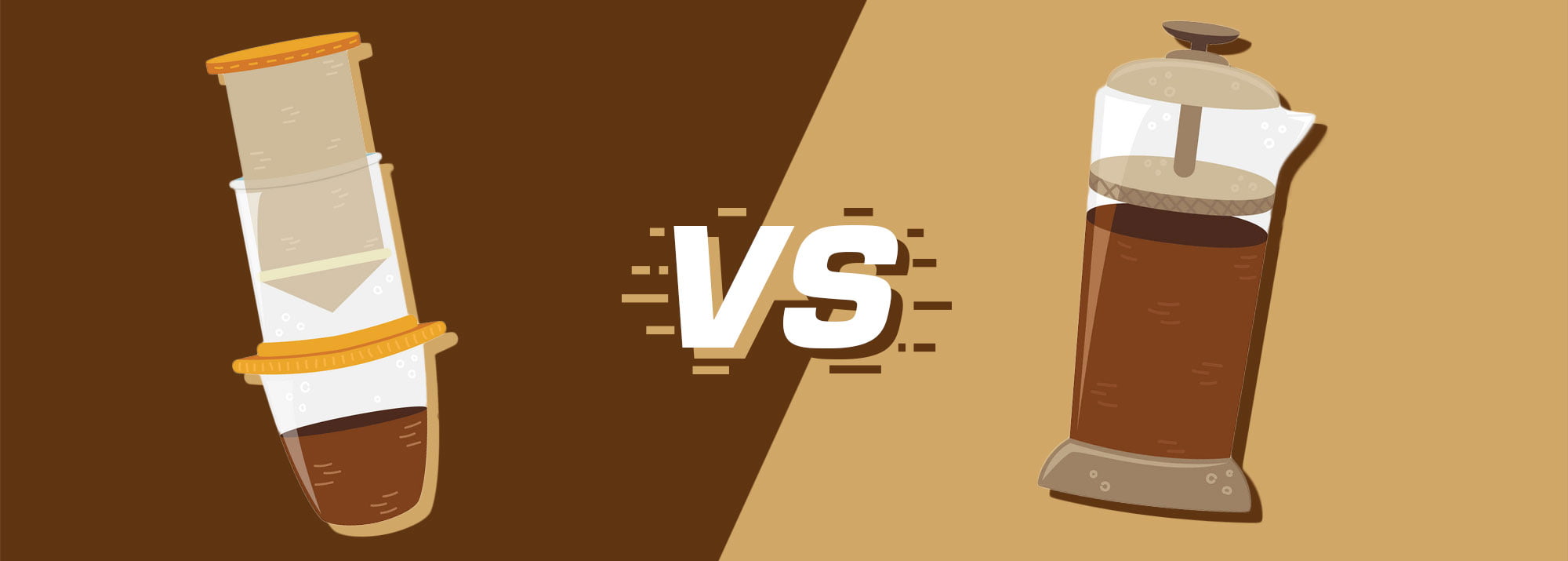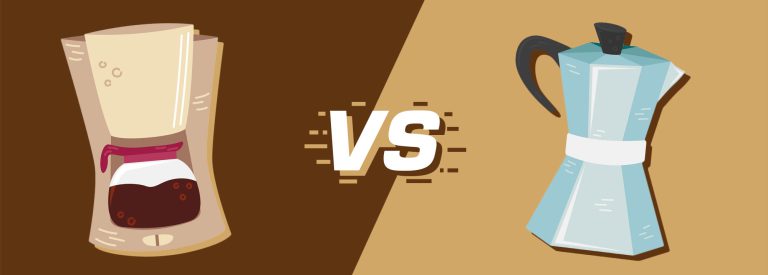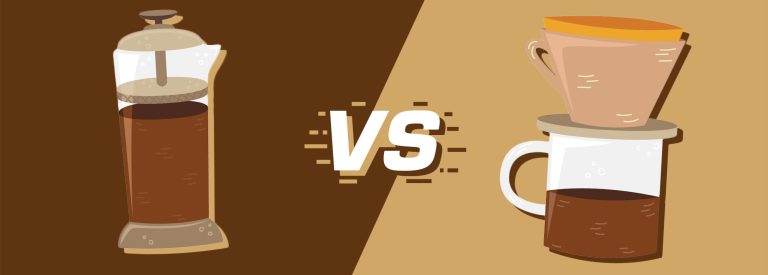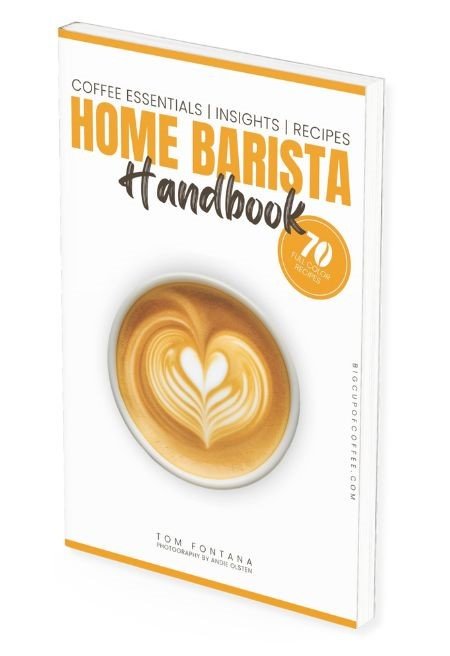AeroPress vs French Press: Which Brewing Method is For You?
I often get asked, what’s the difference between AeroPress and French Press? This comes as no surprise since the two coffee brewing methods both involve immersion brewing and plunging to produce a delicious cup of coffee.
If you also wonder what sets these two apart, I’m here to help you out.
In this article, I’ll compare the AeroPress and French Press to help you make the pick between these two popular brewers.
What is an AeroPress?
The AeroPress is a brewing tool that uses a plunger-like piston to push hot water through coffee grounds, resulting in a smooth and rich cup of joe.
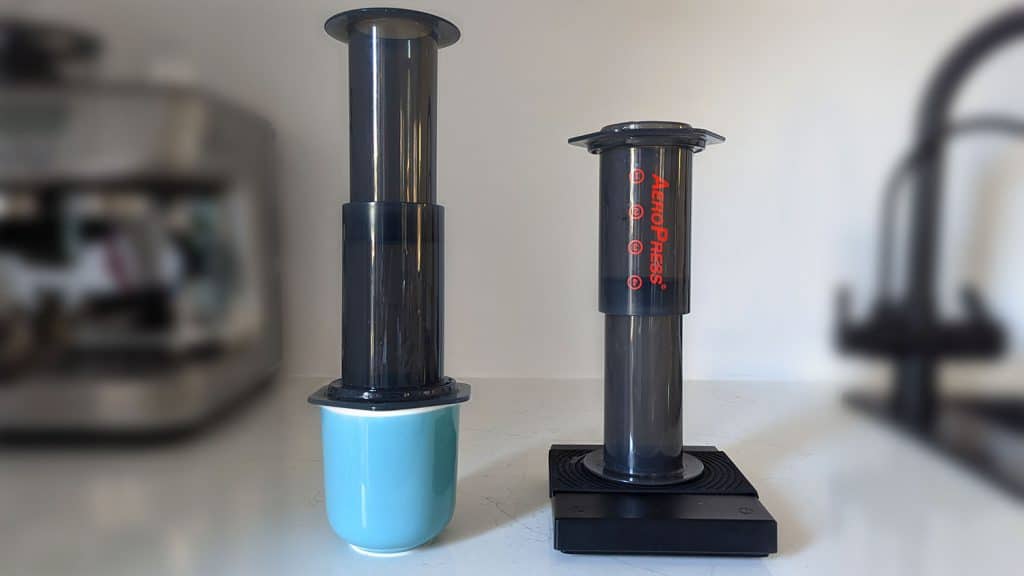
It was invented by Alan Adler in 2005 and was quick to gain popularity among coffee drinkers from different parts of the world.
The first time I saw an AeroPress, I was kind of skeptical because I thought it looked like a low-cost, plasticy French press 🙂 But when I got to try it for myself and learned about how popular it has become, I got to appreciate the resulting cup along with its simplicity, versatility and affordability.
What is a French Press?
Much like the AeroPress, the French press is a brewing device where you put in the coffee grounds and water, let them immerse in a few minutes, and press down on the plunger to filter out some good coffee rich with flavor and coffee oils.
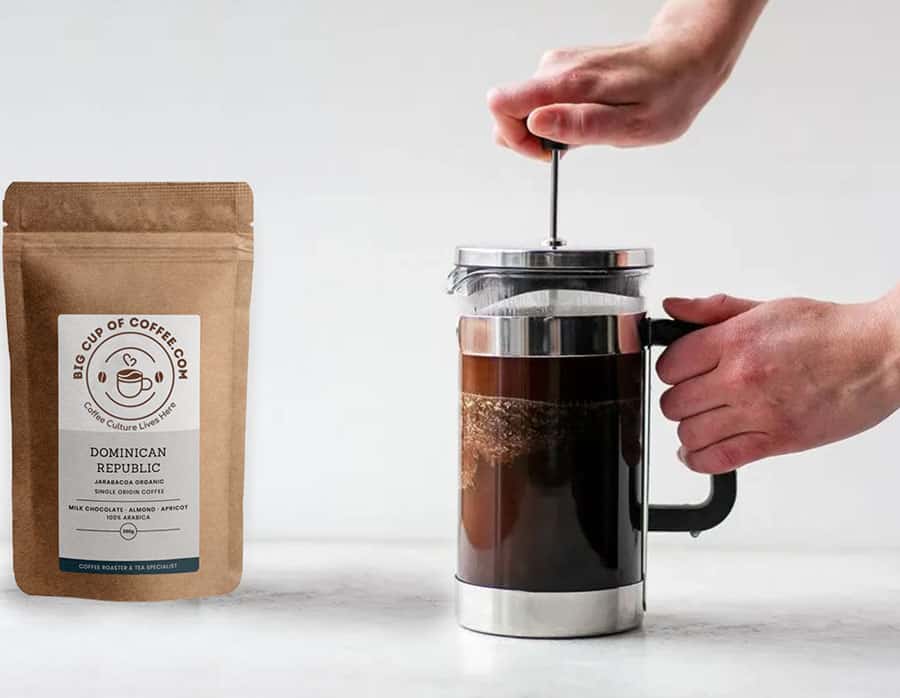
It was first invented in France by Mayer and Delforge in 1852. But it wasn’t until Italian designers Attilio Calimani and Giulio Moneta made some improvements to the design that it became popular worldwide.
Today, the French press is one of the most popular brewing methods thanks to the full-bodied brew that it yields with a simple process. You can make hot coffee, and even cold brew with a french press.
Comparing AeroPress & French Press – Which Method is Better?
So which one is better? There are several aspects that differentiate AeroPress from French Press. Knowing which ones you find more important will help you determine which brewing method is better for you. Have a closer look at these factors below:
| Features | AeroPress | French Press |
|---|---|---|
| Taste & Flavor | Smooth and rich, light to bold strength | Full-bodied, robust flavors, medium to strong intensity |
| Ease of Use | Minimal setup, straightforward brewing process, easy cleanup | Simple to use, requires preheating, requires more cleanup |
| Brewing Speed | 3-4 minutes (including grinding and cleanup) | 6-7 minutes |
| Versatility | Highly customizable (water temperature, grind size, amount of coffee, steeping time, pressure) | Customizable (steeping time, water temperature, coarseness of grounds) |
| Durability & Portability | Sturdy plastic, lightweight, portable | Glass (fragile), stainless steel alternatives for better durability and portability |
| Sustainability | Plastic body, single-use paper filters (can be replaced with reusable filters) | Glass and stainless steel construction, metal mesh filter |
| Cost | $30 to $40 (plus recurring cost for paper filters) | $20 and up (no extra operating expenses) |
Taste, Flavor, & Strength
When it comes to the resulting coffee drink, the AeroPress and French Press offer different results.
The AeroPress produces a cup that is smooth and rich in flavor, and can range from light to bold strengths depending on certain factors such as the beans used. It uses paper filters by defaults, which filters out most of the coffee oils and sediments. The plunger creates around 1 bar of pressure, which really helps in extracting the beans.
On the other hand, the French Press delivers a full-bodied cup of coffee with robust flavors and notes of chocolate, nuts, or caramel which vary based on the coffee beans. It typically gives you medium to strong intensity.
For me though, what really makes the AeroPress superior over the French press is its low acidity without compromising the taste, making it an ideal brew without worries of upsetting your stomach.
Ease of Use
Both the French press and AeroPress offer easy and convenient ways to brew coffee compared to other methods out there.
The AeroPress is particularly easy to use as it requires minimal set-up and has a straightforward brewing process that can be finished in no time. Simply set up your filter, add your medium-fine ground coffee and hot water (175°F to 205°F), let steep, and press. It’s that easy.
Additionally, when you’re done with your brew, cleaning up is also a breeze – just pop out the grinds, and rinse off the plunger and chamber.
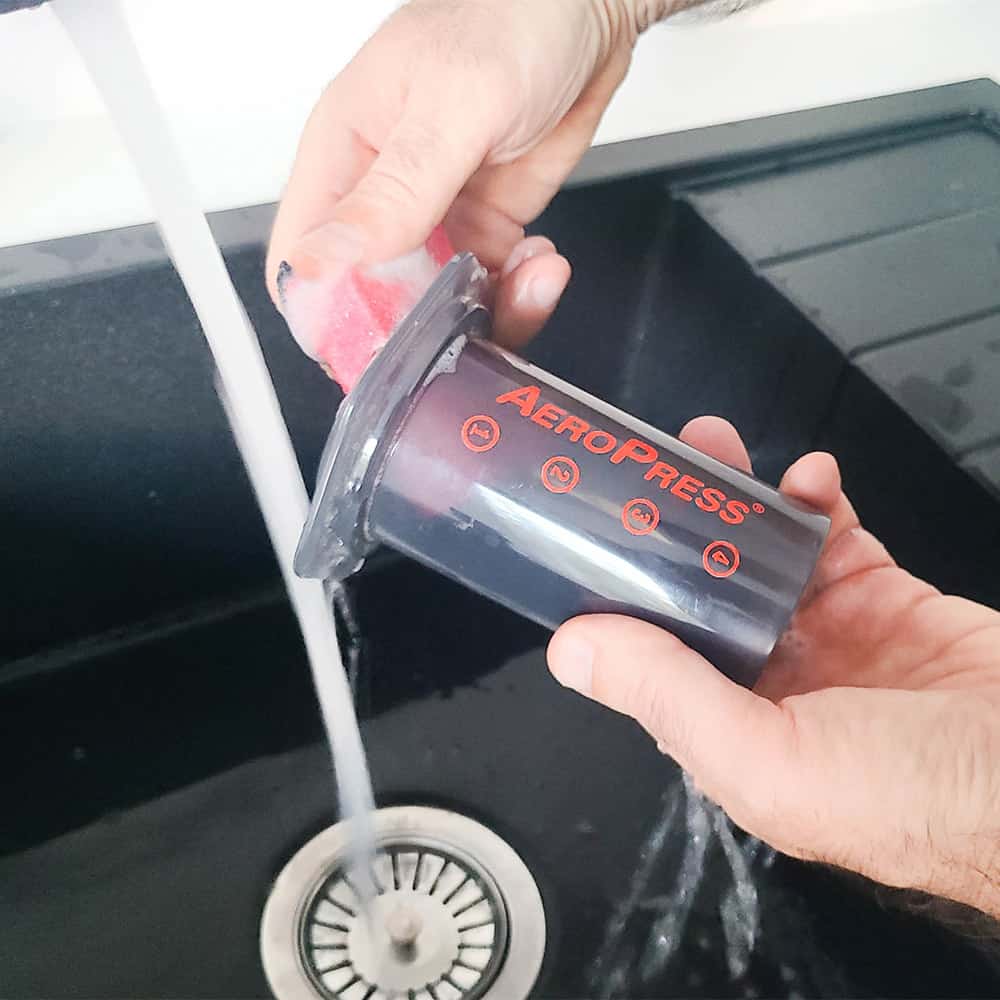
The French press requires more steps than an AeroPress but still remains relatively simple to use regardless. It requires a water temperature ranging from 195°F to 205°F and coffee with a medium coarse grind. But since brewing French press coffee requires a longer steeping time and can lose more heat during the process, it is recommended that you preheat your French press beforehand.
Cleaning a French press is more complicated, since you need to scoop out the grinds from the carafe, and clean the mesh filter.
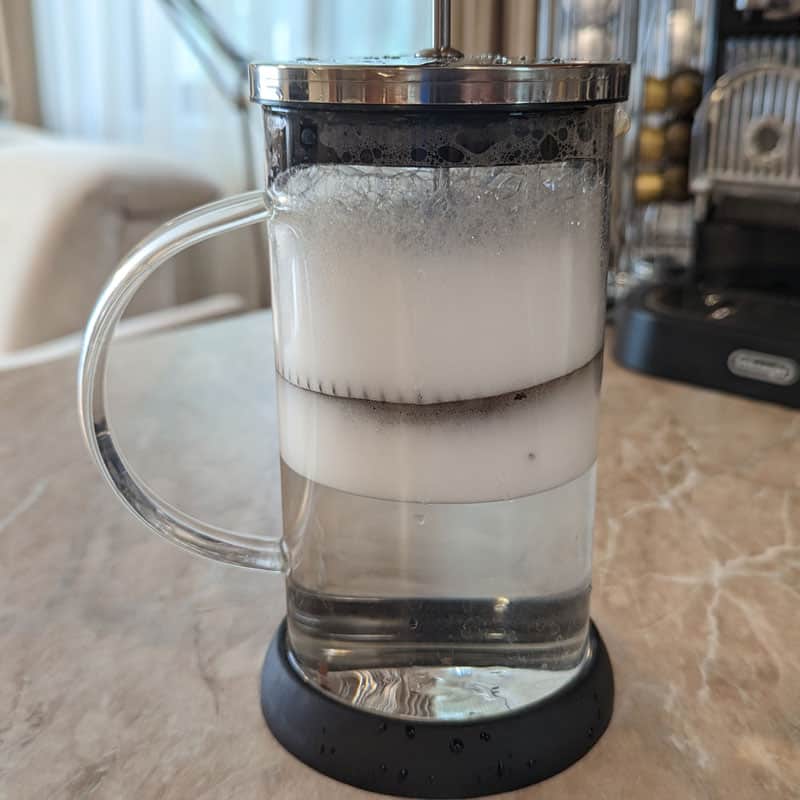
To help guide you, check out my articles “how to clean your AeroPress” and “4 easy ways to clean your French press”.
Brewing Speed
The French Press and AeroPress are no espresso machines, but they can still fix up your cup pretty quickly. However, there are some differences between the two in terms of brewing speed.
- An AeroPress has a total brewing time of around 3-4 minutes which already includes grinding, brewing, and cleaning up.
- French press coffee takes longer at 6-7 minutes.
Aside from a generally longer steep time, the French press features a mesh filter made of stainless steel that requires additional maintenance over time. And because it is made from glass and stainless steel, the French press requires extra scrubbing and gentler handling when you need to clean up.
Versatility
As a coffee lover, having control over your brewing process is key to creating a cup that’s perfect for you. Both the AeroPress and French Press provide this level of versatility, but in slightly different ways depending on what you’re looking for.
When it comes to customization options with an AeroPress, there’s little to no limit. You can control the following:
- Water temperature
- Grind size
- Amount of coffee
- Steeping time
- Pressure applied while plunging
This means that you have the ability to brew anything from a light-bodied cup to a strong and bold Espresso style coffee with the Aeropress. You can make your own recipes which is why they hold yearly AeroPress championships.
The French Press also offers some versatility mainly through controlling factors such as steeping time, water temperature, and the coarseness of grounds used. You can produce cups varying from rich and full-bodied coffees to lighter blends, but this versatility is much less than that offered by the Aeropress.
Now to sizes, the AeroPress is pretty limited with the standard 10 oz, AeroPress Go with an 8 oz capacity, and the AeroPress XL‘s 20 oz capacity.
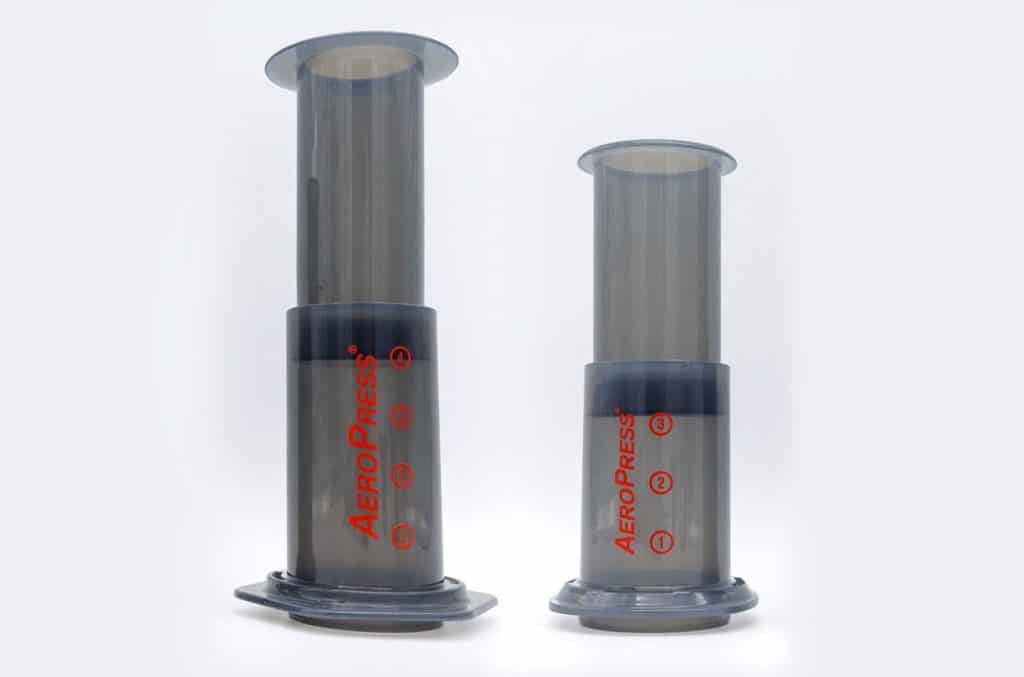
The French press offers much more flexibility in serving size ranging from one cup of coffee to eight servings in one go:
- 3-cup (0.35 L)
- 4-cup (0.5 L)
- 8-cup (1 L)
- 12-cup (1.5 L)
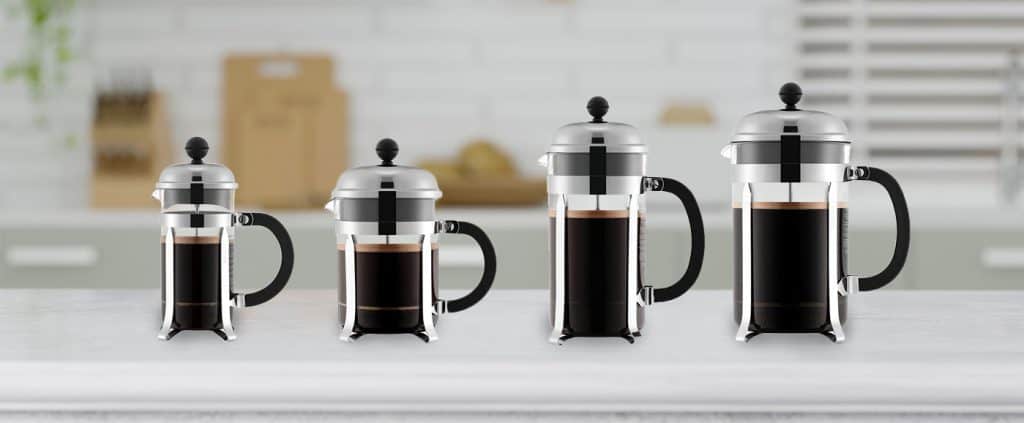
Durability and Portability
When it comes to durability and portability, both the AeroPress and French Press have their pros and cons.
- The AeroPress is made of sturdy plastic materials making it highly durable and perfect for travel. Its compact size and lightweight design allow for brewing on the go or simply moving around the kitchen. The new AeroPress Clear even has a more durable Tritan plastic material.
- On the other hand, some French presses can be quite heavy and fragile due to glass construction when compared with other types of brewers. There are alternatives available though, such as stainless steel models, which offer better durability and portability.
Overall, if you prefer the best durability, you may want to go for a steel French press. But if you really prioritize size and weight for portability, go for an AeroPress.
Sustainability
When it comes to sustainability, there are different factors to consider – from materials used down to the amount of waste produced. Let’s take a closer look at how AeroPress and French Press measure up in this regard.
While both are manual brewers which do not require electricity, the AeroPress is not that eco-friendly because of its plastic body and the need for single-use paper filters (which are compostable by the way). But you can solve this issue with reusable metal or cloth filters, here is an article about all the filters available for this brewer.
On the other hand, the French press is often made with glass and stainless steel which are more environment-friendly and can last long with proper care. It also uses a metal mesh filter resulting in less waste produced.
So if you’re someone who values environmental sustainability just as much as great coffee, then both methods could work out very nicely depending on your particular needs.
For even more sustainable options when you make coffee, you can also explore using shade-grown coffee and recycling your used coffee grounds.
Cost
Both AeroPress and French Press offer different price ranges depending on your budget.
- The AeroPress itself is relatively affordable, with prices generally in the range of $30 to $40, but the single-use paper filters may be a recurring cost unless you use reusable ones. They won’t break the bank though, at $0.02 per filter in 2025.
- The French press has a wider price range from an affordable $20 upwards to several hundred dollars depending on material quality and size. And since it has a built-in metal filter, there are no extra operating expenses.
Overall, both brewing methods offer great value for money based on different preferences. Investing in an AeroPress is definitely worth it if you want portability and versatility, while French presses are for you if you prefer to brew more coffee in one go.
AeroPress and French Press Weighing the Pros & Cons
Now that you know the notable features of each brewing method, here’s an overview of the pros and cons of the French press and AeroPress:
| Brewing Method | Pros | Cons |
|---|---|---|
| AeroPress | – Highly portable – Versatile – Produces smooth and consistent coffee – Low acidity – Fast and easy to use and clean. | – Limited capacity – The plastic body is not eco-friendly. |
| French Press | – Easy to use – Allows for more control over extraction time – The glass material offers decent heat retention | – Some sediments may get into your drink – Common glass build is prone to breakage. |
You can also check out the pros and cons of the AeroPress compared to other brewing methods including:
Meanwhile, here are my comparisons between French press and other brewing methods:
Conclusion
After comparing the AeroPress and French Press, it’s clear that these brewing methods have their own pros and cons. The AeroPress wins when it comes to portability, versatility, and ease of use while the French press offers sustainability, durability of steel variants, and flexibility in sizes.
Personally, I prefer the AeroPress because I really value convenience, and being able to make a great cup of coffee quickly even when I’m traveling just really appeals to me. And I love tinkering with new Aeropress recipes.
At the end of the day though, whichever method you choose is entirely up to your personal preferences in terms of taste, convenience, and your daily routine.
So why not try both out (check out my step-by-step guides on making coffee with an AeroPress and this French Press coffee recipe)and see which one works best for you? Let me know your thoughts in the comments below.

